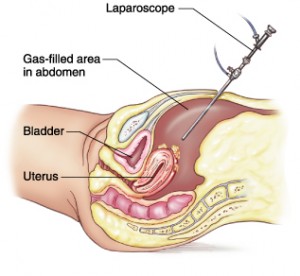What is a Diagnostic Laparoscopy?

Laparoscopy is an outpatient surgery in which a small incision is made on the abdomen. A small, thin telescope, called the laparoscope, is attached to a light cord and is inserted into the abdomen to look at abdominal and pelvic organs. A camera is hooked up to the laparoscope so that the inside of the pelvis and abdomen can be seen on a video monitor. Carbon Dioxide gas is insufflated through one of the channels of the laparoscope into the pelvis to distend the abdomen so that visualization is better. Of course all of the gas is removed at the end of the procedure.
Laparoscopy is used to diagnose the cause of pelvic pain and treat many gynecologic problems such as endometriosis, adhesions, fibroids, ovarian cysts and ectopic pregnancy. If needed, tissue samples can be taken for biopsy. At the time of a diagnostic laparoscopy treatment can also be performed and this is called an operative laparoscopy. During this miniamlly invasive procedure, one or two additional small incisions can be made and instruments inserted so that endometriosis can be destroyed or removed. Or so that scar tissue, ovarian cysts, fibroid tumors, or ectopic pregnancies can be removed.
At the end of the procedure the small incisions are closed and steri-strips and bandaids applied. Laparoscopy is done as an outpatient surgery. Most women can go home the same day that the surgery is performed. The bandaids are left on for 2 days and the steri-strips for 2 weeks. Patients may shower but should cover the bandaids in the shower for the first 2 days. Over the next 2 weeks the steri-strips can be exposed to the shower but should not be scrubbed but blotted dry. Most women are able to go back to many of their activities in 3 or 4 days.
Laparoscopy should be performed by an Ob/Gyn doctor skilled in this minimally invasive procedure. This is important so that treatments if needed can be performed through the laparoscopic small incisions, and so that a larger incision is not made unless absolutely necesarry. Dr Reisler has received many referrals from other ob/gyn and primary care doctors to perform this specialized procedure.
This article is written by Dr Keith Reisler, a Plano Ob/Gyn for 24 years, with extensive experience in laparoscopic treatment of pelvic pain, endometriosis, ovarian cysts, scar tissue, and more. Dr Reisler introduced the operative laparoscopy procedure to the Plano community. He also helped other doctors to learn these techniques. He believes in a minimally invasive approach when possible, and treats and gives second opinions to patients in Plano, Dallas, Richardson, Frisco, Allen, Carrollton, Colony, McKinney, Prosper, Celina, Wylie and surrounding areas.

